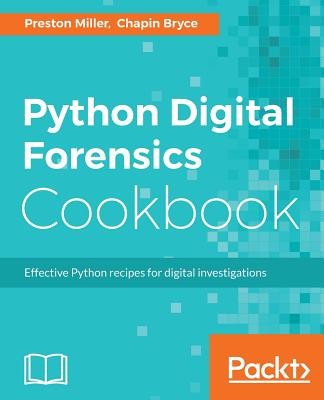
- We will send in 10–14 business days.
- Author: Preston Miller
- Publisher: Packt Publishing
- ISBN-10: 1783987464
- ISBN-13: 9781783987467
- Format: 19.1 x 23.5 x 2.1 cm, softcover
- Language: English
- SAVE -10% with code: EXTRA
Reviews
Description
Over 60 recipes to help you learn digital forensics and leverage Python scripts to amplify your examinations
Key Features:
- Develop code that extracts vital information from everyday forensic acquisitions.
- Increase the quality and efficiency of your forensic analysis.
- Leverage the latest resources and capabilities available to the forensic community.
Book Description:
Technology plays an increasingly large role in our daily lives and shows no sign of stopping. Now, more than ever, it is paramount that an investigator develops programming expertise to deal with increasingly large datasets.
By leveraging the Python recipes explored throughout this book, we make the complex simple, quickly extracting relevant information from large datasets. You will explore, develop, and deploy Python code and libraries to provide meaningful results that can be immediately applied to your investigations. Throughout the Python Digital Forensics Cookbook, recipes include topics such as working with forensic evidence containers, parsing mobile and desktop operating system artifacts, extracting embedded metadata
from documents and executables, and identifying indicators of compromise. You
will also learn to integrate scripts with Application Program Interfaces (APIs) such
as VirusTotal and PassiveTotal, and tools such as Axiom, Cellebrite, and EnCase.
By the end of the book, you will have a sound understanding of Python and how you can use it to process artifacts in your investigations.
What you will learn:
- Understand how Python can enhance digital forensics and investigations
- Learn to access the contents of, and process, forensic evidence containers
- Explore malware through automated static analysis
- Extract and review message contents from a variety of email formats
- Add depth and context to discovered IP addresses and domains through various Application Program Interfaces (APIs)
- Delve into mobile forensics and recover deleted messages from SQLite databases
- Index large logs into a platform to better query and visualize datasets
Who this book is for:
If you are a digital forensics examiner, cyber security specialist, or analyst at heart, understand the basics of Python, and want to take it to the next level, this is the book for you. Along the way, you will be introduced to a number of libraries suitable for parsing forensic artifacts. Readers will be able to use and build upon the scripts we develop to elevate their analysis.
EXTRA 10 % discount with code: EXTRA
The promotion ends in 19d.02:47:36
The discount code is valid when purchasing from 10 €. Discounts do not stack.
- Author: Preston Miller
- Publisher: Packt Publishing
- ISBN-10: 1783987464
- ISBN-13: 9781783987467
- Format: 19.1 x 23.5 x 2.1 cm, softcover
- Language: English English
Over 60 recipes to help you learn digital forensics and leverage Python scripts to amplify your examinations
Key Features:
- Develop code that extracts vital information from everyday forensic acquisitions.
- Increase the quality and efficiency of your forensic analysis.
- Leverage the latest resources and capabilities available to the forensic community.
Book Description:
Technology plays an increasingly large role in our daily lives and shows no sign of stopping. Now, more than ever, it is paramount that an investigator develops programming expertise to deal with increasingly large datasets.
By leveraging the Python recipes explored throughout this book, we make the complex simple, quickly extracting relevant information from large datasets. You will explore, develop, and deploy Python code and libraries to provide meaningful results that can be immediately applied to your investigations. Throughout the Python Digital Forensics Cookbook, recipes include topics such as working with forensic evidence containers, parsing mobile and desktop operating system artifacts, extracting embedded metadata
from documents and executables, and identifying indicators of compromise. You
will also learn to integrate scripts with Application Program Interfaces (APIs) such
as VirusTotal and PassiveTotal, and tools such as Axiom, Cellebrite, and EnCase.
By the end of the book, you will have a sound understanding of Python and how you can use it to process artifacts in your investigations.
What you will learn:
- Understand how Python can enhance digital forensics and investigations
- Learn to access the contents of, and process, forensic evidence containers
- Explore malware through automated static analysis
- Extract and review message contents from a variety of email formats
- Add depth and context to discovered IP addresses and domains through various Application Program Interfaces (APIs)
- Delve into mobile forensics and recover deleted messages from SQLite databases
- Index large logs into a platform to better query and visualize datasets
Who this book is for:
If you are a digital forensics examiner, cyber security specialist, or analyst at heart, understand the basics of Python, and want to take it to the next level, this is the book for you. Along the way, you will be introduced to a number of libraries suitable for parsing forensic artifacts. Readers will be able to use and build upon the scripts we develop to elevate their analysis.


Reviews